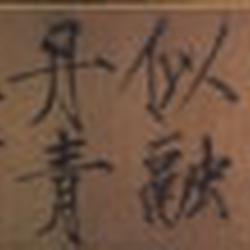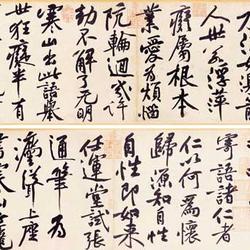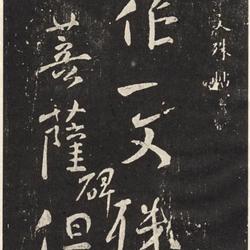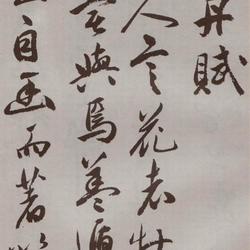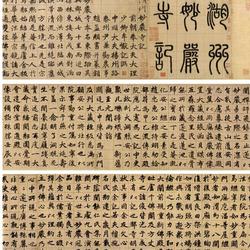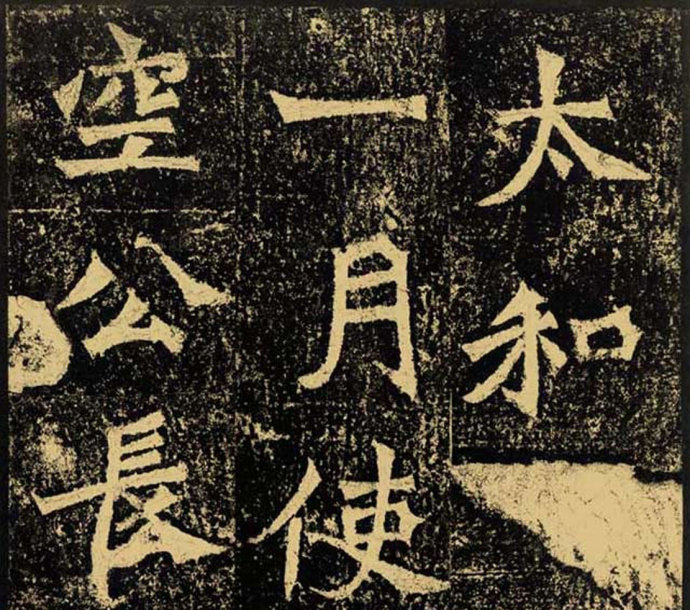
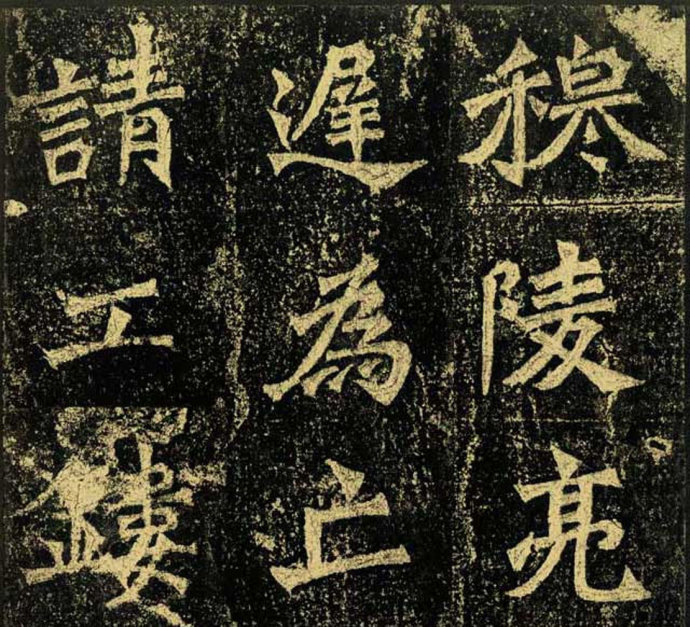
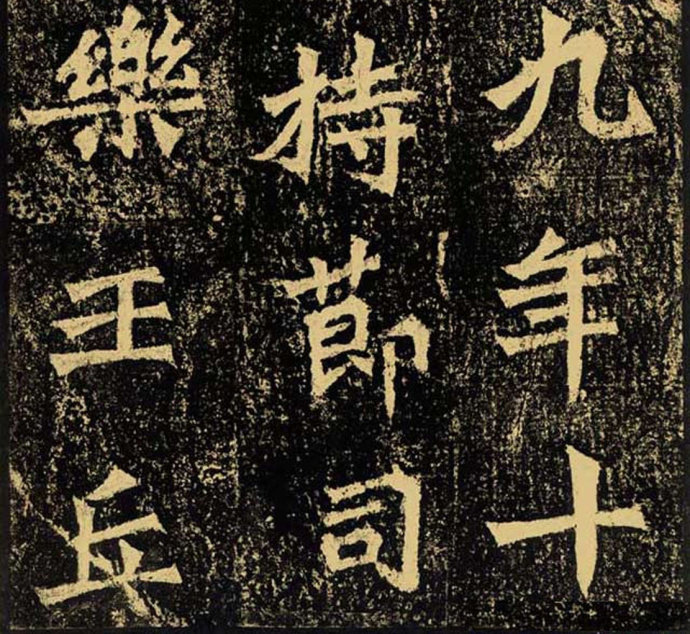

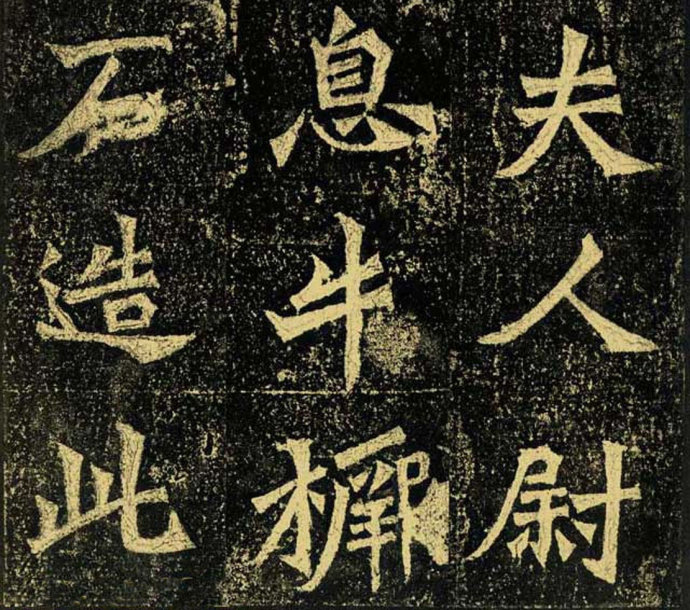
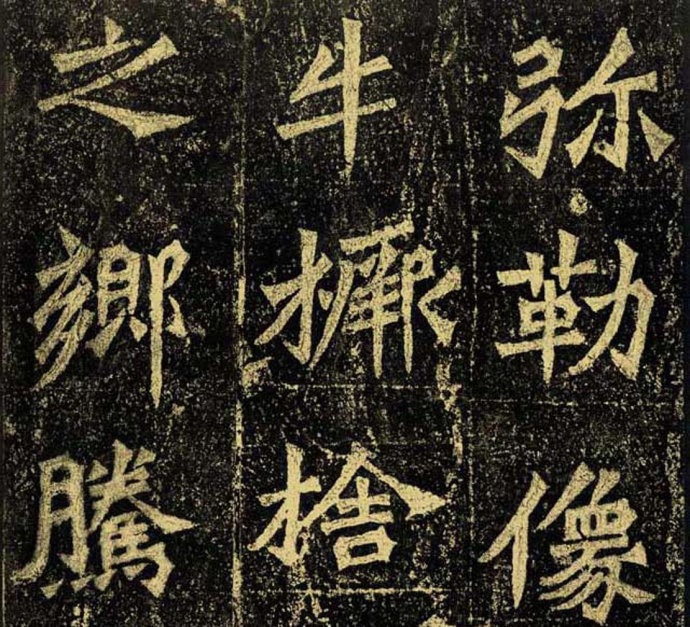
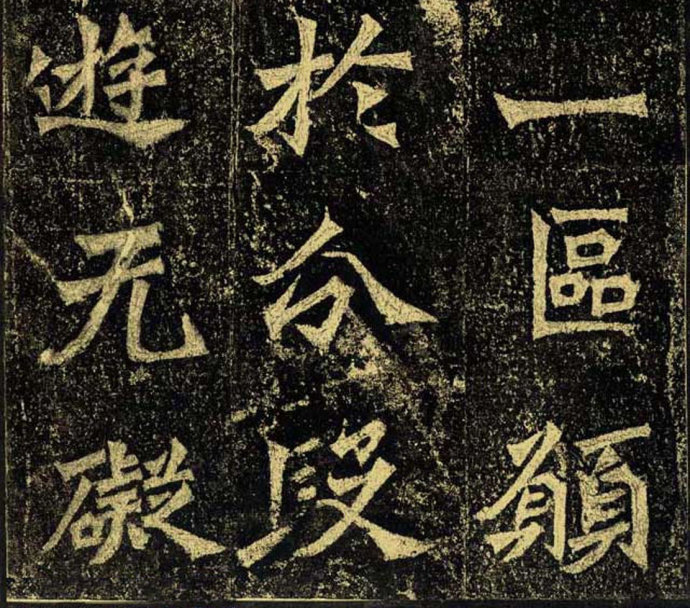
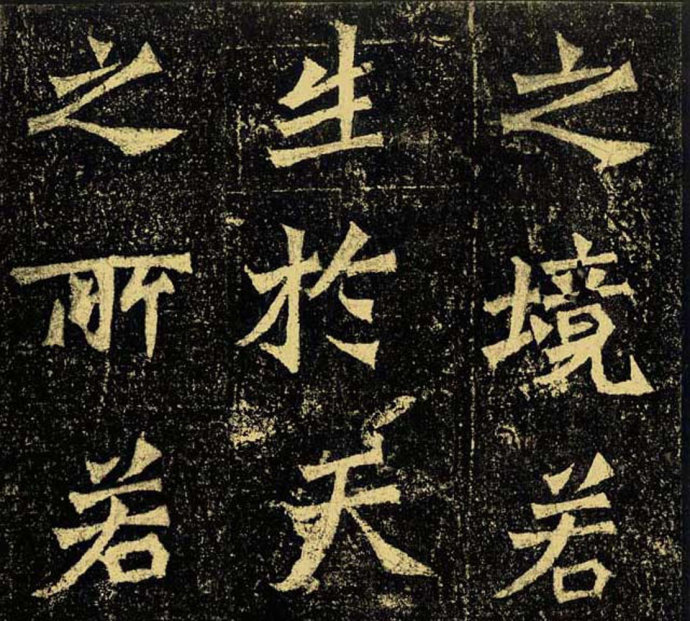
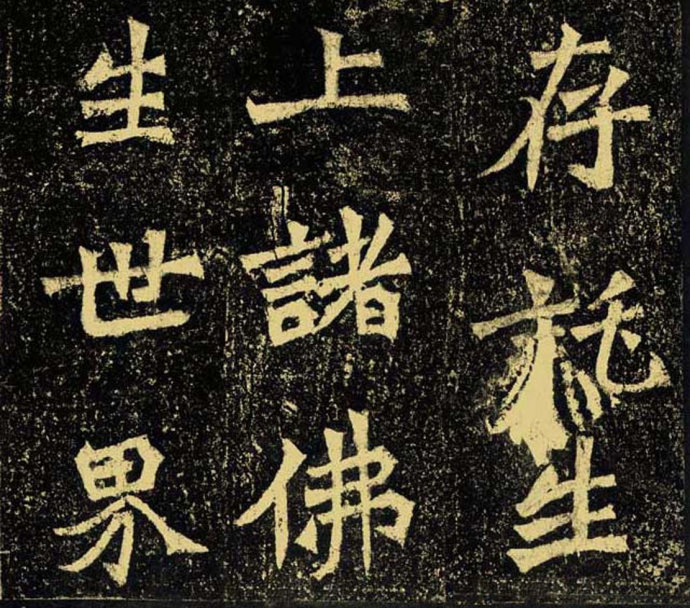
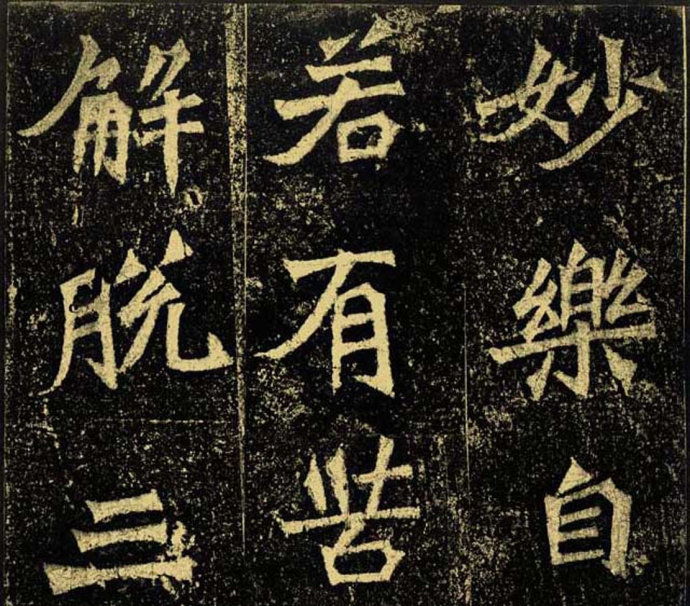
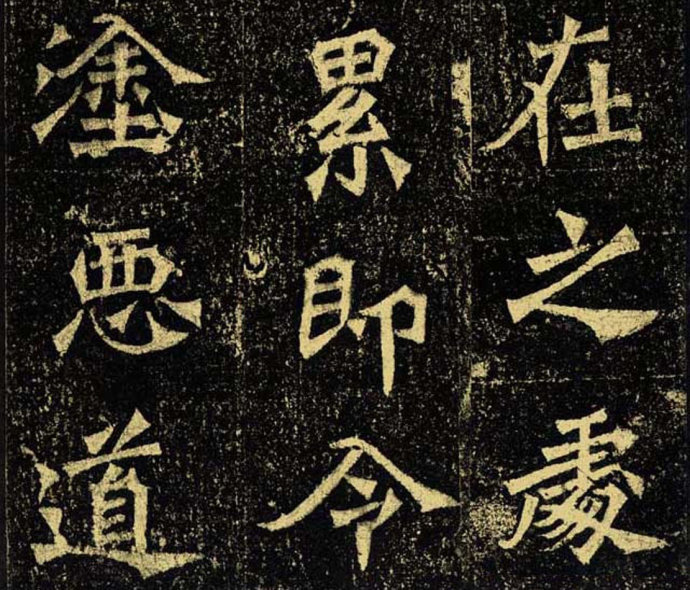
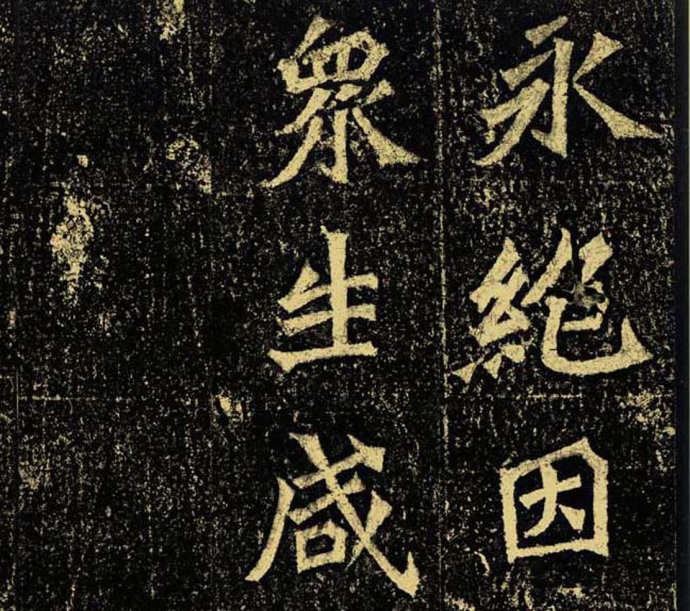
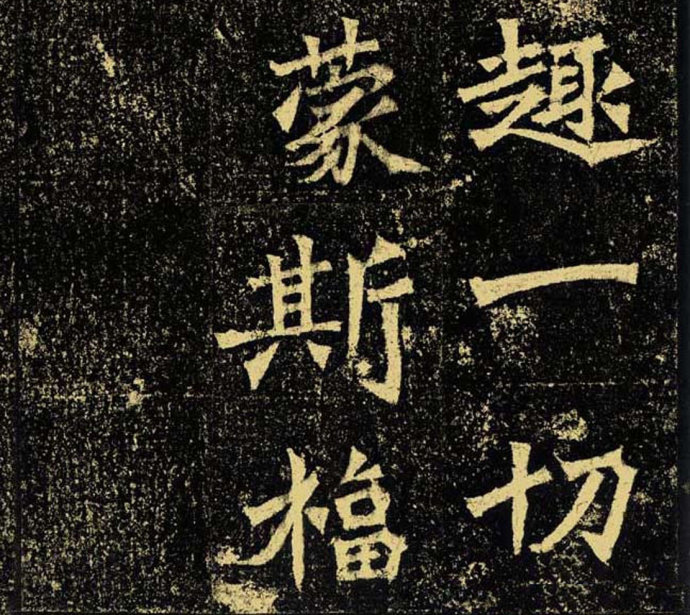
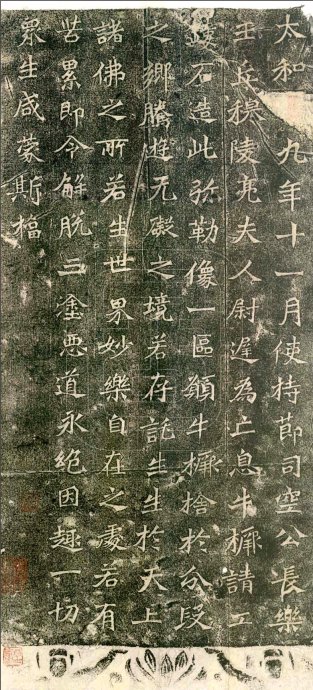
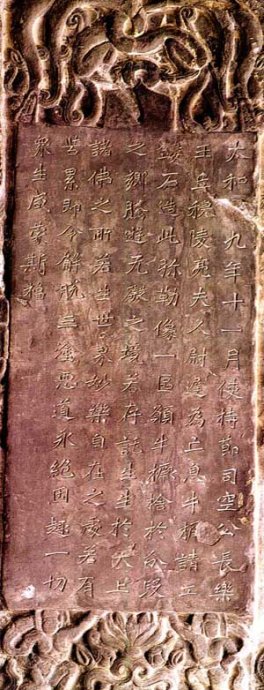
The full name of "The Record of the Statue of Niuzhu" is "The Record of the Maitreya Statue Built by King Qiu Mulingliang and his wife Yuchi in honor of the deceased Niuzhu" in November of the 19th year of Taihe. It is one of the twenty products of Longmen. It is 100 centimeters high and 34 centimeters wide. It was built by Yuchi (later changed to "Wei" surname), wife of Changle King Qiu Mulingliang, for her deceased son Niu Chu. In the past, it was known as the Niu Chu niche. There is a lotus carved in the middle of the statue base, and two strong men on the left and right raise their hands in a lifting gesture, which is a vivid and lifelike image. The font of the inscription is dignified and neat.
The statue niche is on the north side of Guyang Cave, above the Yang Dayan niche. The niche is 140 cm high, 106 cm wide and 21 cm deep. It is in the shape of a round coupon. The lintel is engraved with eleven boys holding flower ropes. The boy is holding a lotus. There are lotus buds carved between the two boys. There is a flying sky at each end and a shallow carving in front of the flying head. Little Feitian. On the left and right below the lintel of the niche, there are donors dressed in Hu clothing. The main statue is a seated Maitreya wearing a crown and crossing his legs. It is the image of the Bodhisattva when Maitreya ascended to Tusita Heavenly Palace. The headlight is engraved with lotus flowers on the inside and seven seated Buddhas on the outside. The outer flame pattern of the backlit external ginseng is composed of seventeen groups of flame patterns with a seated Buddha as the center. The inner layer has ten flying gods on both sides facing each other and supported by necklaces. Two lions crouch under Maitreya's knees, with a strong man crossing their feet and holding Maitreya's feet in their hands.
Qiu Mulingliang's original surname was "Qiu Muling", but he changed his surname to "Mu" after Emperor Wu. Liangzi Youfu, who has been graceful for a long time, was the king of Zhaojun during the reign of Emperor Xianwen. According to the Records of Gaozu in the Book of Wei, Qiu Mulingliang was granted the title of King of Changle in the first year of Yanxing, and later moved to Chijie as an envoy to conquer the West. job. After Sizhou was established, he was promoted to Sizhou Dazhongzheng. During Emperor Xiaowen's expedition to the south, Emperor Xiaowen made Liang the Minister of Records and stayed in Luoyang, where he was favored by Emperor Gaozu. Later, he impeached himself because his brother had dismissed his duties, and moved to Dunqiu County (today's north of Puyang City, Henan Province) to be the Duke of Kaiguo. He died in the third year of Jingming (AD 502) at the age of 52. Liang had many official positions in his life. This statue is engraved with the positions of his most famous ones, "Shichijie", "Sikong Gong" and "King of Changle", to show his glory. The statue was created around the time when Emperor Gaozu was on his southern expedition and Qiu Mulingliang stayed in Luoyang.
The statue is 100 centimeters high and 34 centimeters wide. It was built by Yuchi (later changed her surname to "Wei"), the wife of Changle King Qiu Mulingliang, for her deceased son Niu Chu. It used to be called the Niu Chu niche. There is a lotus carved in the middle of the statue base, and two strong men on the left and right raise their hands in a lifting gesture, which is a vivid and lifelike image. The font of the inscription is dignified and neat.
The calligraphy style of the Northern Dynasties is reflected in a large number of statues, inscriptions, inscriptions, and epitaphs. In the 18th year of Taihe in the Northern Wei Dynasty (AD 494), Emperor Xiaowen of the Northern Wei Dynasty moved the capital to Luoyang, and Luoyang became the cultural center of the north for a while. The royal family promoted Buddhism, so the practice of digging grottoes and carving Buddhist statues in Longmen became popular. Most of these statues were accompanied by inscriptions, leaving very rich calligraphy art relics to later generations. Although most of the writers did not leave their names and life experiences, this just proves the mass nature of calligraphy activities in the Northern Wei Dynasty. Their calligraphy level is very high. Starting from the colorful mixed regular script and official script, they gradually formed a new calligraphy image that is strong, vigorous, lively and lively, with a rigorous structure, a stable posture, and the separation of momentum completely disappears. Basically unified the regular script style.
The most famous inscriptions on the statues in Longmen Grottoes are "The Statue of Niu Zhu", "The Statue of Shi Ping Gong", "The Statue of Yang Dayan", "The Statue of Sun Qiusheng", and "The Statue of Xue Fashao in Wei Lingzang". These calligraphy works are all representative works of Northern Wei calligraphy, and each has its own characteristics. Since the Qing Dynasty, people have imitated the ancient titles of "paintings" and "book products" and selected the inscriptions on Longmen statues. Titles such as "Twenty Ranks of Longmen".
"Niu Zha Statue" is a piece of work that is upright and neat, with a strong style and a tight structure yet open and stretched. Every word in the inscription is vigorous and sharp. When the strokes are drawn horizontally, the strokes are often made sideways and obliquely. The strokes are sharp and the points are formed into triangles. The vertical strokes are made like hanging needles. The turning points are heavy and heavy. They are sharp, decisive and hearty. The strong wind. The shape of the characters tends to become flatter, the structure is dense and stretched left and right, the expression is broad and broad-minded, and the artistic conception is ancient. It is a masterpiece among the regular scripts of the Northern Wei Dynasty. The Liaohe Forest of Steles engraved the inscriptions on his statues in the ancient museum.
After the Dao and Xian Dynasties in the Qing Dynasty, the study of stele became more and more prosperous, and the calligraphy circle became increasingly interested in the art of Longmen stone carving calligraphy. Until the early Republic of China, several types of "Longmen Four Products", "Longmen Ten Products", and "Longmen Twenty Products" gradually appeared. Among the selected rubbings, "Twenty Products of Longmen" is the most popular. Among them are: "Twenty Pieces of Longmen Statues" lithographed by Zhengshu Company; "Twenty Pieces of Longmen Statues" printed by Nigensha in Japan; compiled into an offset edition in Japan's "Shuyuan"; "Twenty Pieces of Longmen Statues" printed by Yiyuan Zhenshangshe "; Cultural Relics Publishing House has printed "Twenty Products of Longmen" from the Qianjia rubbings collected by the Beijing Library. From the Qianjia to the late Qing Dynasty, Longmen calligraphy was highly praised by many calligraphers and scholars. Bao Shichen praised in "Yizhou Shuangji" that "the writing of the Northern Dynasties was sharp and solemn, and the writing was astringent but the momentum was arranged." After Kang Youwei conducted an in-depth and detailed study of the twenty works of Longmen, he wrote: "Guang Yizhou: Song Qi, Liang and Chen" highly praised it and praised it for its ten qualities: "strong courage, vigorous momentum, jumping brushwork, thick stipples, strange and elegant moods, flying spirit, full of interest, and deep bones." Da, the structure is natural, the flesh and blood are rich." He also said, "There are no bad steles in the Wei Dynasty. Although the statues are made by poor people, the bones and blood are rough, there are abnormalities in the thickness, and the characters are also very close... Therefore, we can choose the study of the statues of the Wei Dynasty. He is now able to write on his own."
Explanation:
In November of the 19th year of Taihe, the envoy Chijie Sikonggong Changle Wangqiu
Yuchi, wife of Mulingliang, asked a craftsman to carve out the stone for the dead cattle prong, and built this
In the Maitreya Statue area, I hope that the oxen and prongs will be laid down in the land of divisions, and they will be able to fly without hindrance.
In the realm of existence, if you are born in the place of Buddhas in the sky, if you are born in the world,
Where wonderful happiness is at ease, if there is suffering and tiredness, you will be liberated from the three evil realms.
All sentient beings will be blessed forever.

